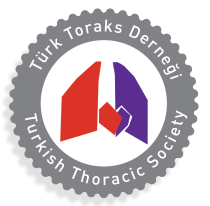Abstract
Abstract
Carcinoid tumours are classified as neuroendocrine tumours and the lungs are the second most common site. Unlike small cell cancers, bronchial carcinoids are accepted as low grade tumours. They are usually confined within the bronchial wall and grow into the bronchial lumen. Thus, parenchyma saving resections are widely accepted and preferred treatment method. In this study, surgically treated bronchial carcinoid tumours were reviewed in regard to diagnostic methods and treatment modalities as well as the results of long term follow up.
Between January 1991 and July 2001, 32 cases of surgically treated bronchial carcinoid tumours were retrospectively reviewed. There were 21 (66%) female with a mean age of 40.2±17.3 years (16-65 years).
Tumours were equally distributed to each lung. Origin of the tumour was main bronchi in 10, lobar or segmental bronchus in 20, and peripheral in 2 cases. The most frequently encountered symptoms were cough, haemoptysis, sputum production, and recurrent chest infections. Fiberoptic or rigid bronchoscopy itself revealed definite diagnosis in 30 (94%) of cases, however an exploratory thoracotomy was necessary for the remaining 2 (6%) patients. None of them sustained major haemorrhage during bronchoscopic biopsy. Type of resection was lobectomy in 20, bronchoplastic resection in 8 and pneumonectomy in 4 patients. Histopathology revealed 30 typical and 2 atypical carcinoids, most of which (n=28, 88%) were being in Stage 1. Median follow up time was 49 (7-126) months for the entire series and none of them developed either local recurrence or distant metastasis.
Universally accepted method of treatment for bronchial carcinoid tumours is complete resection with preservation of as much normal lung tissue as possible. Intra-operative sampling of broncho-pulmonary and mediastinal lymph nodes is mandatory for an accurate staging and aids to delineate the extent of resection.



